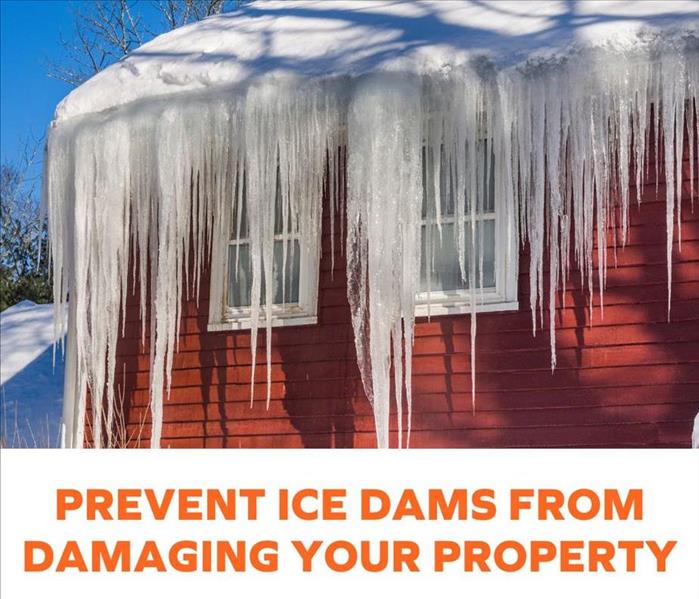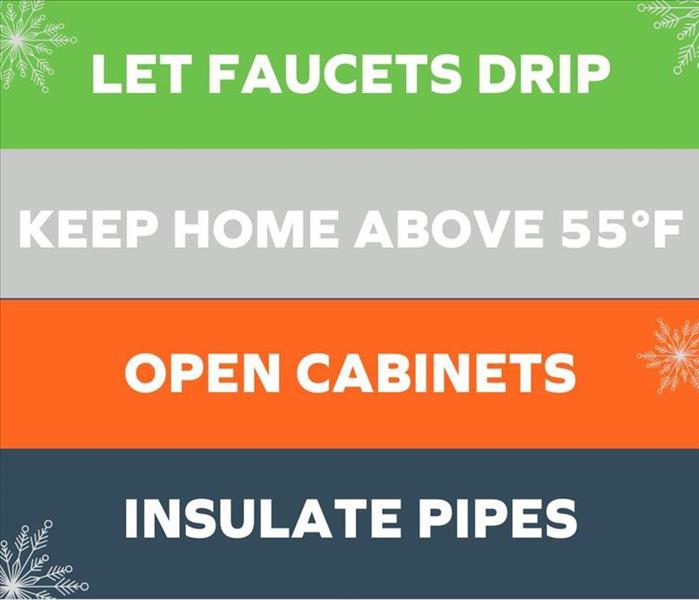Recent Posts
Understanding Ice Dams and How to Address Their Impact
1/23/2025 (Permalink)
As Central Pennsylvania grapples with sub-zero temperatures, homeowners face the heightened risk of ice dams. These pesky formations are not just a winter inconvenience; they can lead to significant property damage if left unchecked.
Here's everything you need to know about ice dams, their prevention, potential damage, and how SERVPRO Team Weaver can help.
What Are Ice Dams?
Ice dams form when snow on your roof melts, flows down, and refreezes near the eaves, where temperatures are colder. Over time, this ice buildup creates a barrier that prevents proper drainage, forcing water to seep under shingles and into your home.
How Do Ice Dams Form?
- Heat Escape: Warm air escapes from the attic, melting the snow on the roof.
- Cold Eaves: The melted snow freezes as it reaches the cooler edges of the roof.
- Blocked Drainage: This frozen barrier traps subsequent meltwater, which can then leak into your home.
Damage Ice Dams Can Cause
Ice dams can wreak havoc on your property, including:
- Water Damage: Leaks can penetrate walls, ceilings, and insulation, leading to water stains and mold growth.
- Structural Damage: Repeated freezing and thawing can compromise roofing materials and gutters.
- Decreased Energy Efficiency: Damaged insulation allows heat to escape, raising heating costs.
Preventing Ice Dams
Proactive measures are essential to prevent ice dams:
- Improve Insulation: Proper attic insulation minimizes heat escape.
- Ventilation: Ensure adequate attic ventilation to keep roof temperatures consistent.
- Snow Removal: Use a roof rake to remove snow buildup safely.
SERVPRO Team Weaver: Your Partner in Ice Dam Damage Restoration
If ice dams have already caused damage, SERVPRO Team Weaver is here to help. We specialize in restoring your home to preloss condition, offering:
- Water Damage Restoration: We address leaks and mitigate water damage with advanced equipment.
- Mold Remediation: Our team ensures your home is free from mold caused by trapped moisture.
- Emergency Services: With our “Faster to any size disaster” promise, we act quickly to minimize damage????.
Why Choose SERVPRO Team Weaver?
- 24/7 Availability: We’re always ready to respond to your emergencies.
- Skilled Professionals: Our highly trained team utilizes industry-leading techniques and technology.
- Comprehensive Solutions: From assessment to final restoration, we handle every step of the process.
- Commitment to Excellence: Our goal is to make it "Like it never even happened."
This winter, don’t let ice dams compromise your safety and comfort. Stay proactive with prevention, and trust SERVPRO Team Weaver to restore your home should damage occur.
Contact us today for expert guidance and prompt service.
Protect Your Property from Frozen Pipes
1/22/2025 (Permalink)
Cold weather can lead to significant damage from frozen pipes. Follow these tips to safeguard your home or business:
- Set thermostats to 55°F or higher to keep your pipes above freezing temperature.
- Drip cold water from the faucet farthest from the main water valve. Continuous water flow helps prevent freezing.
- Locate your main shut-off valve for emergencies and mark it for easy access.
- Insulate pipes in unheated areas like basements, crawl spaces, or garages.
- Open cabinets and vanities to allow warm air to circulate around exposed pipes.
- Drain and shut off outdoor spigots by closing interior valves, then leave the exterior spigot open. This helps any remaining water expand without causing pipe breaks.
- Prepare early for freezing temperatures by draining outdoor irrigation systems and sealing drafty areas around pipes.
Thawing Frozen Pipes
If you suspect your pipes have frozen, act quickly to prevent further damage:
- Confirm the issue: Ask a neighbor if they’re experiencing water loss; if not, your pipes are likely frozen.
- Turn off water at the main valve to avoid flooding when the ice thaws.
- Open faucets: Allow water to flow as ice melts, reducing pressure and speeding up thawing.
- Apply safe heat sources: Use a hair dryer or portable heater, but keep heat away from flammable materials. Avoid open flames, blow torches, or any method that could cause boiling or pipe damage.
- Inspect for leaks or cracks after thawing and turn the water back on slowly to check for damage.
In Case of Burst Pipes
- Turn off water immediately using your main shut-off valve.
- Call SERVPRO® to address water damage and ensure your property is restored "Like it never even happened®."
Prevent Fires in State College and Centre County with Professional Dryer Vent Cleaning
10/16/2024 (Permalink)
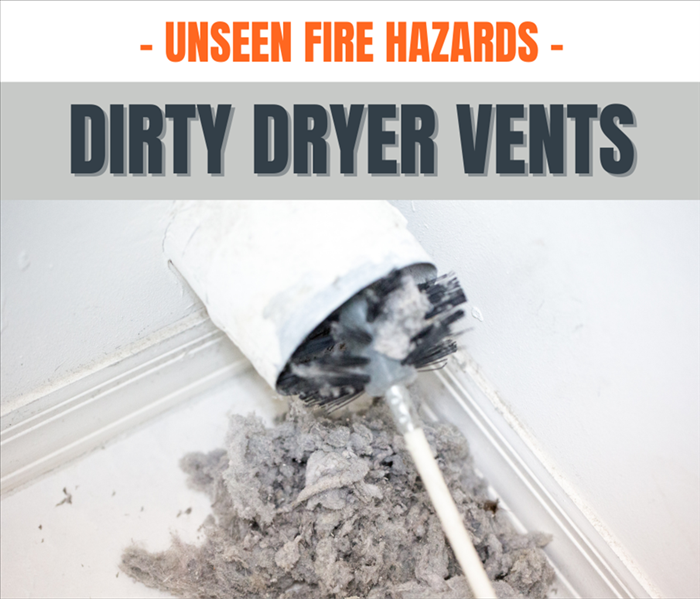 A dirty dryer vent could be a fire hazard lurking in your home.
A dirty dryer vent could be a fire hazard lurking in your home.
Fire cleanup in State College, Bellefonte, and throughout Centre County often stems from preventable causes like clogged dryer vents. Every year, many home fires occur due to neglected dryer vent maintenance, leading to significant fire restoration costs. SERVPRO Team Weaver offers professional dryer vent cleaning services that can reduce fire risks and keep your dryer operating efficiently. Regular cleaning is a crucial step in protecting your home from fire hazards and costly damage.
How Clogged Dryer Vents Contribute to Fires
When lint, dust, and debris build up in dryer vents, it restricts airflow, causing the dryer to overheat. This buildup creates a major fire hazard, as lint is highly flammable. A simple spark can ignite a serious fire, resulting in the need for fire cleanup in Bellefonte, State College, and other Centre County areas. According to the U.S. Fire Administration, one of the leading causes of home fires is failure to clean dryer vents. Professional cleaning is essential for reducing this risk.
Why You Need Professional Dryer Vent Cleaning
- Fire Prevention: Professional cleaning clears blocked vents, preventing overheating and lowering the risk of fire.
- Increased Efficiency: Clean vents help your dryer run more efficiently, cutting drying times and saving on energy costs.
- Extended Appliance Lifespan: A well-maintained dryer doesn’t have to overwork, meaning it will last longer and require fewer repairs.
- Peace of Mind: SERVPRO Team Weaver uses specialized equipment to thoroughly clean your vent system, ensuring it’s safe and debris-free.
How Often Should Dryer Vents Be Cleaned?
To minimize the risk of fire in Centre County, it's recommended to have your dryer vents professionally cleaned at least once a year. If you use your dryer frequently or notice longer drying times, it’s wise to schedule a cleaning sooner.
Why Delay Could Be Dangerous
Failing to clean your dryer vent can result in dangerous outcomes, including house fires and carbon monoxide poisoning in homes with gas dryers. The extra strain on your dryer also increases the likelihood of costly repairs or replacements. Instead of risking fire restoration needs, take preventative action now by scheduling a professional cleaning.
At SERVPRO Team Weaver, we’re dedicated to keeping homes in State College, Bellefonte, and all of Centre County safe from fire hazards. Don’t wait until it’s too late—schedule a dryer vent cleaning today to protect your home and family.
Contact SERVPRO Team Weaver for Dryer Vent Cleaning
If you haven’t had your dryer vent cleaned recently, act now to prevent a potential fire. Contact SERVPRO Team Weaver to schedule a professional dryer vent cleaning service. Visit our website or call us at (814) 996-4603 to learn more and book your appointment today.
Costly Mistakes To Avoid When Making A Fire Damage Claim
10/8/2024 (Permalink)
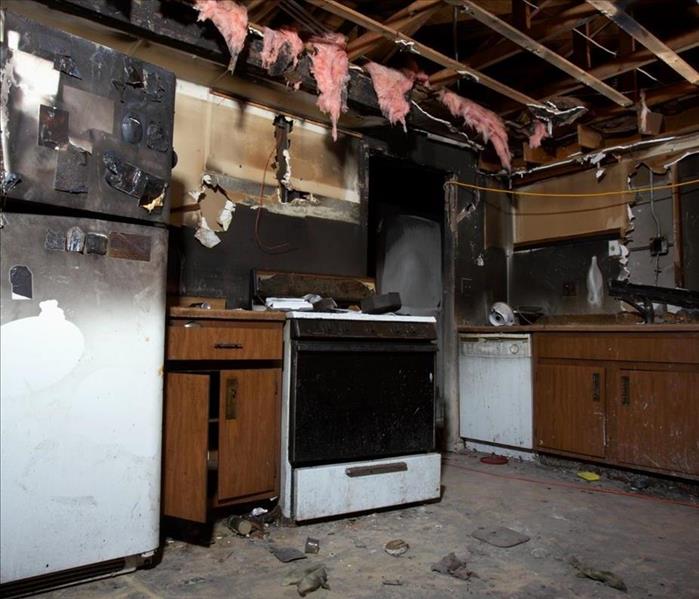 An unattended pot caused extensive fire damage to this State College kitchen.
An unattended pot caused extensive fire damage to this State College kitchen.
Dealing with a fire at your home or business is tough enough without the added stress of navigating insurance claims. The process can be overwhelming, especially when you're already dealing with the emotional and physical toll of fire damage. But here's the thing: having a professional like SERVPRO® in your corner can make a huge difference.
We specialize in both restoration and working directly with your insurance company to make sure your claim is handled correctly, saving you time and frustration.
Why You Should Trust SERVPRO to Handle Your Fire Claim
SERVPRO is more than just a restoration company—we’re your partner in navigating the entire fire damage process, from start to finish. Our team doesn’t just clean up; we coordinate with your insurance company to ensure everything is covered and handled properly. Fire claims can be tricky, and missing a step could cost you in the long run. When you work with us, you can rest easy knowing we’re handling the fine print, so you don’t have to.
Understanding the Fire Claims Process
Filing a claim after fire damage can be complex, but we know exactly how to streamline it. Once you call us, we act fast. We immediately assess the damage, document everything for your claim, and ensure the right steps are taken to prevent further issues. By working directly with your insurance adjuster, we make sure the entire process runs smoothly, saving you from the hassle of multiple calls and coordination.
Here’s how the process typically works:
- Immediate Notification: Contact your insurance company to start the claim process. Don’t worry—SERVPRO will guide you through this step.
- Detailed Damage Assessment: Our team will create a comprehensive list of damaged items and structural damage. We’ll submit this directly to your adjuster to ensure nothing is missed.
- Insurance Adjuster Coordination: We work with your insurance adjuster to assess both fire and water damage, ensuring every inch of damage is properly covered.
- Fast Cleanup and Mitigation: SERVPRO handles everything from soot and water damage to structural cleaning, deodorization, and mold remediation. And we document it all so your claim stays on track.
- Claims Management: Once your claim is approved, we ensure the restoration funds are used efficiently and effectively, getting your property back to normal as quickly as possible.
Why Speed Matters: The SERVPRO Advantage
When you experience fire damage, every minute counts. The sooner your claim is filed, the faster the cleanup can begin—and the less damage you’ll have to deal with. With SERVPRO on the job, we act quickly to minimize further damage and get your property restored fast. We’re known for our rapid response, which is key to limiting damage and avoiding costly delays. Plus, we’ll take care of filing your claim promptly to prevent any slowdowns from the insurance company.
What You Can Do While Waiting for Us
While SERVPRO is on its way, there are a few things you can do to protect your property:
- Safety First: Make sure it’s safe to enter the property before you go back inside.
- Ventilation: Open windows and doors to help reduce smoke and soot buildup.
- Turn Off Utilities: Shut off water, gas, and electricity to avoid further damage.
- Protect Valuables: If it’s safe, remove valuable items to prevent further damage.
- Document the Damage: Take pictures and notes of everything affected—SERVPRO will help with this, but getting started early never hurts.
Leave the Documentation to Us
One of the most tedious parts of a fire claim is documenting everything for the insurance company. SERVPRO takes that burden off your shoulders. We meticulously document all damage—taking photos, creating inventories, and keeping track of receipts for any emergency repairs. This way, your insurance company has all the evidence needed to approve your claim quickly and without issues.
Avoiding Costly Mistakes in Your Fire Claim
There are some common mistakes people make when filing fire claims that can lead to delays or even claim denials. SERVPRO ensures these are avoided by handling the process professionally:
- Overlooking Secondary Damage: Fires don’t just cause burns. We make sure smoke, soot, and water damage from firefighting efforts are all properly included in your claim.
- Understanding Your Policy Limits: We work with your insurance company to make sure you understand what’s covered and what isn’t, so there are no surprises.
- Keeping Proper Documentation: SERVPRO keeps meticulous records of everything we do on your property, ensuring every detail is accounted for in your claim.
Why SERVPRO Is the Best Choice for Fire Mitigation
Fire mitigation and restoration require expertise, speed, and the right equipment—this is where SERVPRO excels. We don’t just stop the damage; we also use advanced equipment to clean, deodorize, and restore your property to pre-fire condition. Our certified technicians handle everything from soot removal to structural cleaning and odor elimination. With our fast response and expert knowledge, we minimize damage and help you get back to normal as soon as possible.
- Comprehensive Services: From initial damage control to complete restoration, we handle every step of the process.
- Expertise in Claims Management: We have extensive experience working with insurance companies, ensuring your claim is processed quickly and correctly.
- Emergency Board-Up Services: We can secure your property right after the fire to prevent further damage from weather or vandalism.
- State-of-the-Art Equipment: SERVPRO uses the latest technology for deodorization, water extraction, and mold prevention, ensuring the job is done right the first time.
Conclusion: Why SERVPRO Should Be Your Go-To Team
Filing a fire claim and handling the cleanup can be overwhelming, but it doesn’t have to be. SERVPRO is here to make the entire process as painless as possible. From working directly with your insurance company to handling every aspect of mitigation and restoration, we’re the experts you need in your corner.
Call SERVPRO Team Weaver today at (814) 996-4603, and let us make your fire damage “Like it never even happened.”
Protect Yourself Against Water Damage By Knowing the Most Common Causes
3/13/2024 (Permalink)
Water damage in homes and businesses in State College and the surrounding areas can arise from various sources, often leading to costly repairs and restoration if not promptly addressed. Understanding the common causes can help in preventing potential damage.
Here are some of the most frequent culprits:
- Leaking Pipes: Pipes that burst or develop leaks from wear, tear, or freezing can cause significant water damage. Hidden leaks can also occur within walls, leading to mold and structural damage over time. Wintertime in Central PA is when we receive the most calls concerning burst or leaking pipes.
- Appliance Failures: Household appliances like washing machines, dishwashers, water heaters, and refrigerators can malfunction, causing significant water leaks. Hoses can become loose, or the appliances themselves might develop leaks due to aging or faulty connections. If you are heading out of town for any length of time, it is vital that you have someone you trust check on your home regularly to be sure none of your appliances are leaking. Also, don't leave the house with a load or dishes or laundry running, as tempting as that may be!
- Blocked Drains and Toilets: Clogged drains and toilets can lead to overflow, resulting in water leakage that can affect flooring, walls, and underlying structures. If you run into a serious clog, call a professional instead of trying to fix it yourself. We have seen serious water losses come from diy drain repairs.
- HVAC Issues: Air conditioners and heating systems that are not properly maintained can cause water accumulation, leading to leakage. The condensation lines can get clogged, or the drip pans can overflow, causing water to leak into the building structure. Be sure to clean your units at the beginning and end of each season of use.
- Faulty Water Heaters: Old or poorly maintained water heaters can rupture, releasing large amounts of water all at once and causing immediate flooding. If you suspect your aging water heater has seen better days, have it inspected by a licensed plumber.
- Severe Weather and Natural Disasters: Heavy rains, hurricanes, floods, and rapid snow melts are significant sources of water damage. These natural events can lead to water penetrating structures, causing extensive damage to buildings.
- Roof Leaks: Damaged or deteriorating roofs can allow water to seep into the home during rainstorms or from melting snow, leading to damage in ceilings, walls, and other areas. It's more cost effective to repair a roof than a roof and all of your home's contents. #costlyrepairs
- Poor Drainage Around the Building: Improper grading around a building's foundation can lead to water pooling and eventually entering the building, causing damage to the foundation and interior spaces.
- Sump Pump Failure: If a sump pump fails during heavy rain or flooding, water can overflow and flood the basement or crawl spaces, leading to significant damage. During Central PA's winter thaw and spring time rain, it is especially important to check on your sump pump regularly to be sure it is free of clogs and operating properly.
- Condensation: Areas with high humidity or spots in the home that remain cool and moist, like crawl spaces or basements, can have condensation build-up, leading to water damage over time. Eventually, you will experience mold growth that can impact your health.
- Overflowing Gutters and Downspouts: When gutters are clogged with debris, they can overflow and allow water to pool around the foundation, potentially leading to water intrusion and damage. While fall is the obvious time to think about cleaning your gutters, it is something that should be done year-round.
Understanding these common causes can help you take preventative measures to avoid the costly and inconvenient consequences of water damage. Regular maintenance checks, timely repairs, and proper installations are crucial in mitigating the risk of water-related damage.
While we hope that you never have to call us, we are Here to Help® if you do. Reach SERVPRO of Happy Valley directly at (814) 996-4603.
SERVPRO of Happy Valley is located off of College Avenue between Houserville and Lemont. Visit us at 2595 Clyde Ave, Suite 1, State College, PA 16801.
Long-Term Strategies to Protect Your Property from Water Damage
10/21/2023 (Permalink)
 Water damage can be a homeowner's worst nightmare, causing extensive and costly repairs.
Water damage can be a homeowner's worst nightmare, causing extensive and costly repairs.
Water damage can be a homeowner's worst nightmare, causing extensive and costly repairs. While restoration after a water incident is crucial, implementing long-term strategies to prevent future occurrences is equally important. In this blog post, we will explore effective methods for water damage prevention beyond restoration, providing you with practical tips to safeguard your property.
Regular Maintenance Checks
- Plumbing system: Inspect your plumbing system regularly for leaks, loose connections, and corrosion. Fix any issues promptly to prevent water damage.
- Roof and gutters: Ensure your roof is in good condition and your gutters are clean and free from debris. Proper drainage is essential to avoid water seepage and roof leaks.
- Appliances: Pay attention to appliances that utilize water, such as washing machines, dishwashers, and water heaters. Check for leaks, replace old hoses, and schedule regular maintenance checks.
Proper Landscaping
Ensure your property's grading promotes water flow away from your foundation. Redirect downspouts and install appropriate drainage systems to prevent water accumulation. Plant trees and shrubs far enough from your foundation to prevent root intrusion that could lead to plumbing issues or foundation damage.
Installing and Maintaining Preventive Measures
Install a sump pump with a battery backup system in your basement or crawl space. Regularly test the pump and ensure the discharge pipe is clear of obstructions. You can also consider installing water leak detectors and automatic shut-off valves for early detection and prevention of leaks, especially in areas prone to water incidents such as basements or laundry rooms.
Proper Insulation and Ventilation
Adequate insulation throughout your property, including attics, walls, and crawl spaces, prevents condensation and the formation of moisture that can lead to water damage. Proper ventilation in bathrooms, kitchens, and other areas with high humidity levels helps reduce moisture buildup, preventing mold growth and water damage.
Educate and Engage
Its important to teach everyone in your household about water-saving habits, proper maintenance, and what to do in case of a water incident or leak. Consult with water damage restoration professionals who can provide expertise, conduct inspections, and recommend improvements to minimize the risk of future water damage.
By implementing these long-term strategies for water damage prevention, you can protect your property and avoid the costly and stressful process of restoration. Regular maintenance, proper landscaping, preventive measures, insulation, and ventilation are crucial investments that will help safeguard your home against water damage. So, take the necessary steps today and enjoy peace of mind knowing that you are proactively protecting your property from future water incidents.
Lessons from Historic Northeast Storms: Enduring Impact on Homes and Properties
9/11/2023 (Permalink)
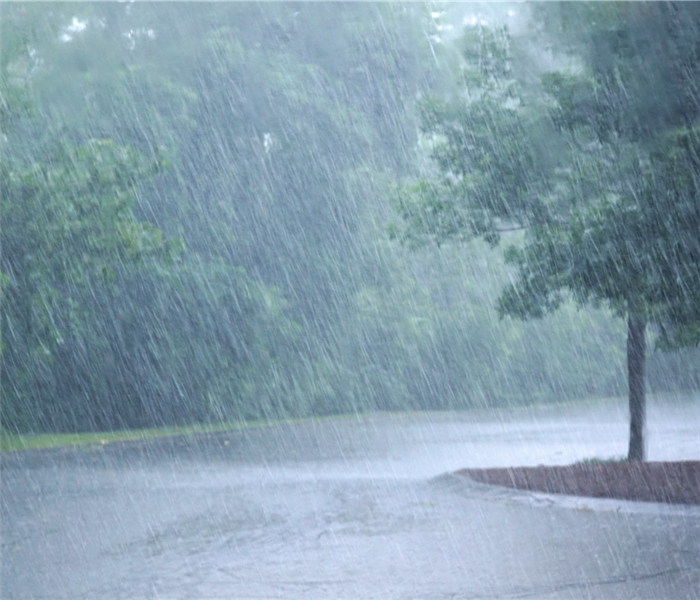 The lessons learned from historic storms have had a profound impact on how property owners prepare for and respond to extreme weather events.
The lessons learned from historic storms have had a profound impact on how property owners prepare for and respond to extreme weather events.
The Northeastern United States has a long history of enduring powerful and historic storms that leave a lasting impact on homes and properties. As a homeowner or property owner in this region, understanding the lessons learned from past storms is essential to better prepare for future weather events. In this blog, we'll explore some of the most significant historic Northeast storms, the valuable lessons they taught us, and the enduring impact they have had on homes and properties.
The Great New England Hurricane (1938)
The Great New England Hurricane of 1938, also known as the Long Island Express, was one of the most devastating storms to hit the region. With winds exceeding 120 mph, it caused widespread destruction to homes, properties, and infrastructure. The lesson learned from this historic storm was the importance of early warning systems and preparedness. Today, homeowners have access to advanced weather forecasting and emergency alerts, empowering them to take timely precautions when a storm is on the horizon.
The Blizzard of 1978
The Blizzard of 1978 remains one of the most infamous storms in Northeastern history. With record-breaking snowfall and fierce winds, it paralyzed cities and towns, leaving homes buried and properties inaccessible for days. This historic event highlighted the significance of having a well-stocked emergency kit, including food, water, blankets, flashlights, and batteries. Property owners learned the value of investing in snow removal equipment and planning for prolonged power outages.
Superstorm Sandy (2012)
Superstorm Sandy, a hybrid storm formed from a hurricane and a winter storm, struck the Northeast in 2012. This unprecedented storm caused extensive flooding, wind damage, and power outages, affecting millions of homes and properties. Homeowners realized the importance of elevating their homes in flood-prone areas and investing in flood insurance. Property owners also recognized the need for strengthening infrastructure and coastal protection measures to mitigate the impact of future storms.
The "Bomb Cyclone" (2018)
The "Bomb Cyclone" that hit the Northeast in 2018 brought a rapid drop in atmospheric pressure, resulting in intense snowfall and blizzard conditions. This storm demonstrated the significance of proper insulation and weatherproofing to protect homes from extreme cold and prevent heat loss. Homeowners learned to seal gaps and cracks, add extra insulation, and ensure their heating systems were in excellent working condition to endure such frigid conditions.
Lessons for Home and Property Insurance
Historic Northeast storms have also underscored the importance of having adequate home and property insurance coverage. Many homeowners have faced significant financial losses due to storm-related damage. Understanding the terms and coverage of insurance policies is crucial for making informed decisions and ensuring that homes and properties are adequately protected against storm-related risks.
The lessons learned from historic Northeast storms have had a profound and lasting impact on how homeowners and property owners prepare for and respond to extreme weather events. Early warning systems, emergency preparedness, and investing in weather-resistant infrastructure have become crucial pillars of storm readiness. Homeowners have become more aware of the importance of fortifying their properties against the forces of nature and having comprehensive insurance coverage to mitigate potential financial losses. By drawing from the experiences of past storms, we can better equip ourselves and our properties to weather any future challenges that come our way.
Key Measures to Protect Your Business from Fire Disasters
8/16/2023 (Permalink)
Fire disasters can be devastating for any business, causing significant damage to property, disrupting operations, and putting the safety of employees and customers at risk. As a business owner, taking proactive measures to protect your business from fire disasters is crucial. In this blog post, we will discuss three key measures you can implement to safeguard your business from the threat of fire.
Fire Prevention and Risk Assessment
Preventing fires should be a primary focus for every business. Conducting a thorough fire risk assessment is the first step in identifying potential hazards and implementing preventive measures. Walk through your premises with a trained professional to identify possible ignition sources, flammable materials, and any other fire risks. Common areas to pay attention to include electrical systems, heating and cooling equipment, storage areas, and office spaces.
Based on the risk assessment findings, develop a fire prevention plan tailored to your business. This plan should include measures such as regular maintenance of electrical systems, proper storage, and handling of flammable materials, installation and regular inspection of fire extinguishers, and implementation of fire safety protocols.
Fire Detection Systems
Early detection of fires is critical in minimizing damage and ensuring the safe evacuation of everyone in your business premises. Installing reliable fire detection systems is essential for a quick response. Consider installing fire alarm systems with smoke and heat detectors that are interconnected and monitored 24/7.
Additionally, consider incorporating automatic fire sprinkler systems. These systems can significantly suppress or extinguish fires before they spread, providing an extra layer of protection to your property and assets. Regularly test and maintain these systems to ensure they are functioning optimally and conform to applicable regulations.
Emergency Preparedness and Employee Training
Preparing your employees for emergencies is vital to ensure their safety and the smooth evacuation of your premises. Develop and practice an emergency evacuation plan that includes clear escape routes, designated meeting points outside the building, and specific roles assigned to employees during an emergency.
Regularly conduct fire drills to familiarize employees with evacuation procedures and ensure they understand their roles in emergency situations. Provide training on the proper use of fire extinguishers and other firefighting equipment. Encourage employees to report any potential fire hazards they notice and to maintain a safe and organized working environment.
In addition to emergency preparedness, having a well-documented and accessible emergency contact list is essential. This list should include contact information for local fire departments, emergency services, and key personnel within your organization.
Implementing these three key measures will significantly enhance your business's ability to prevent, detect, and respond to fire disasters effectively. By prioritizing fire safety, regularly reviewing and updating your fire prevention strategies, and investing in the right equipment and training, you can protect your business, employees, and customers from the devastating effects of fires. Remember, fire safety is a continuous effort that requires the commitment and involvement of everyone in your organization.
What Can Cause a Flooded Basement?
7/27/2023 (Permalink)
A flooded basement is a homeowner's nightmare, causing significant damage. Understanding the common culprits behind basement flooding is crucial for prevention and prompt action. In this blog post, we'll explore various factors that can cause a flooded basement, ranging from weather-related issues to plumbing mishaps and structural problems. By identifying these causes, you can take proactive steps to safeguard your basement and prevent costly water damage.
Heavy Rainfall and Poor Drainage
One of the primary causes of basement flooding is heavy rainfall. When rainwater accumulates around the foundation of your home, it can seep into the basement through cracks, gaps, or faulty waterproofing. Inadequate or clogged exterior drainage systems, such as gutters and downspouts, can exacerbate the problem by directing water toward the foundation instead of away from it.
Ensure proper grading around your home, directing water away from the foundation. Clean and maintain gutters and downspouts regularly to ensure efficient water flow. Consider installing a sump pump and a perimeter drainage system to help redirect water away from your basement.
Plumbing Issues
Plumbing failures, such as burst pipes, leaking water heaters, or malfunctioning sump pumps, can quickly lead to basement flooding. A small leak or a sudden pipe rupture can release a significant amount of water, saturating your basement in a short period.
Regularly inspect your plumbing system for signs of leaks, corrosion, or wear and tear. Ensure that your sump pump is in good working condition and consider installing a backup battery or water-powered sump pump for added protection.
Sewer Backup
Sewer backups occur when the main sewer line becomes overwhelmed by excessive water or blockages, causing wastewater to flow back into your home. This can result in a hazardous and unsanitary situation, leading to basement flooding.
Install backflow prevention devices, such as check valves or gate valves, to prevent sewage from flowing back into your home. Regularly maintain your sewer lines and avoid flushing items that can clog the system.
Foundation Issues
Cracks in your foundation walls or floor can allow water to seep into your basement during periods of heavy rain or when the groundwater level rises. Poor foundation drainage, hydrostatic pressure, or inadequate waterproofing can contribute to basement flooding.
Inspect your foundation regularly for cracks or signs of deterioration. Address any foundation issues promptly, including repairing cracks and improving exterior drainage. Consider applying waterproof coatings or sealants to protect your basement from water intrusion.
Malfunctioning or Insufficient French Drains
French drains are designed to collect and redirect groundwater away from your foundation. If these drains become clogged, damaged, or insufficient in size, they may fail to effectively channel water away, leading to basement flooding.
Regularly inspect and maintain your French drain system, ensuring it is clear of debris and functioning properly. If needed, consult a professional to assess and improve the efficiency of your drainage system.
A flooded basement can result in extensive damage and pose risks to your home's structure and your family's health. By understanding the common causes of basement flooding, you can take proactive measures to prevent such incidents. Regular maintenance, proper drainage, foundation inspections, and addressing plumbing issues promptly are essential for protecting your basement from water damage. Remember, consulting a professional in case of significant water intrusion or persistent basement flooding is advisable to ensure comprehensive solutions and minimize the risk of future incidents.
SERVPRO's Collaboration with Gutster Brands
6/23/2023 (Permalink)
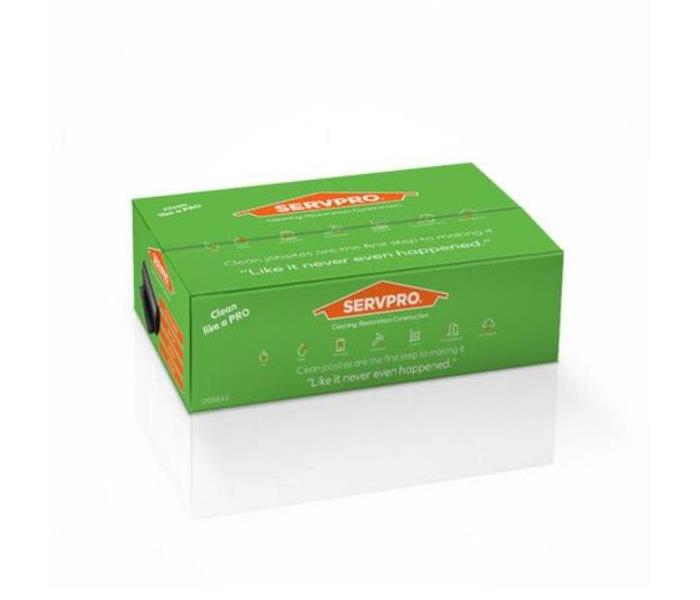 We've partnered with Gutster Brands to create 100 percent recycle content garbage bags.
We've partnered with Gutster Brands to create 100 percent recycle content garbage bags.
At SERVPRO of Happy Valley, we strive to do more than just talk about the environment – we take action to make a positive impact. That's why we are proud to announce our collaboration with Gutster Brands to bring 100% recycled content garbage bags to our franchise. These eco-friendly bags are not only beneficial for the environment, but they also represent our commitment to sustainable business practices.
Our franchise has worked closely with Gutster Brands for over a year to secure a competitive price on these garbage bags while maintaining their high quality and eco-friendly nature. As a result, we have become the first SERVPRO franchise to receive these branded garbage bag boxes.
Here are some key points about our new garbage bags:
- They are made of 100% recycled content, which is higher than most other brands that range from 0% to 90%.
- All the scraps used in the production of these bags come from the USA, ensuring a positive impact on the domestic plastic problem.
- Our collaboration with Gutster Brands reflects our dedication to making real changes in our business practices to help the environment.
At SERVPRO of Happy Valley, we understand the importance of environmental sustainability, especially for our clients in the Happy Valley area. By using these 100% recycled content garbage bags, we are actively contributing to the reduction of plastic waste and promoting eco-friendly practices within our industry.
We invite you to join us in our commitment to protecting the environment and making a real difference in our community. If you have any questions about our eco-friendly garbage bags or other sustainable practices, please feel free to contact us. Together, we can make a positive impact on the environment while providing the highest quality restoration and cleaning services.



 24/7 Emergency Service
24/7 Emergency Service
